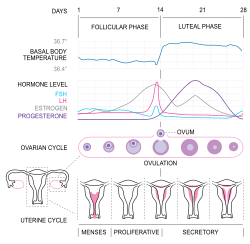Basal body temperature


| Basal body temperature | |
|---|---|
| Background | |
| Type | Fertility awareness |
| First use | 1930s |
| Failure rates (first year) | |
| Perfect use | 0.3% |
| Typical use | 3.1[1]% |
| Usage | |
| Reversibility | Immediate |
| User reminders | Dependent upon strict user adherence to methodology |
| Clinic review | None |
| Advantages and disadvantages | |
| STI protection | No |
| Period advantages | Prediction |
| Weight gain | No |
| Benefits | No side effects, can aid pregnancy achievement |
Basal body temperature is the lowest temperature attained by the body during rest (usually during sleep). It is generally measured immediately after awakening and before any physical activity has been undertaken, although the temperature measured at that time is somewhat higher than the true basal body temperature (see Fig. 1). In women, ovulation causes an increase of one-half to one degree Fahrenheit (one-quarter to one-half degree Celsius) in basal body temperature (BBT); monitoring of BBTs is one way of estimating the day of ovulation. The tendency of a woman to have lower temperatures before ovulation, and higher temperatures afterwards, is known as a biphasic pattern. Charting of this pattern may be used as a component of fertility awareness.
BBT as a Birth Control Method
Hormonal causes of biphasic patterns
The higher levels of estrogen present during the pre-ovulatory (follicular) phase of the menstrual cycle lower BBTs. The higher levels of progesterone released by the corpus luteum after ovulation raise BBTs. The rise in temperatures can most commonly be seen the day after ovulation, but this varies and BBTs can only be used to estimate ovulation within a three day range.[2]
If pregnancy does not occur, the disintegration of the corpus luteum causes a drop in BBTs that roughly coincides with the onset of the next menstruation. If pregnancy does occur, the corpus luteum continues to function (and maintain high BBTs) for the first trimester of the pregnancy. After the first trimester, the woman's body temperature drops to her pre-ovulatory normal as the placenta takes over functions previously performed by the corpus luteum.
Very rarely, the corpus luteum may form a cyst. A corpus luteum cyst will cause BBTs to stay elevated and prevent menstruation from occurring until it resolves, which could take weeks or months.
While trying to conceive
Regular menstrual cycles are often taken as evidence that a woman is ovulating normally, and irregular cycles is evidence she is not. However, many women with irregular cycles do ovulate normally, and some with regular cycles are actually anovulatory or have a luteal phase defect. Records of basal body temperatures can be used to accurately determine if a woman is ovulating, and if the length of the post-ovulatory (luteal) phase of her menstrual cycle is sufficient to sustain a pregnancy. Some fertility computers and software can help a woman to determine these factors.
Pregnancy tests are not accurate until 2-3 weeks after ovulation. Knowing an estimated date of ovulation can prevent a woman from getting false negative results due to testing too early. Also, 18 consecutive days of elevated temperatures means a woman is almost certainly pregnant.[3]
Tracking basal body temperatures is a more accurate method of estimating gestational age than tracking menstrual periods.[4]
While avoiding pregnancy

Charting of basal body temperatures is used in some methods of fertility awareness, and may be used to determine the onset of post-ovulatory infertility. However, BBTs only show when ovulation has occurred; they do not predict ovulation. Normal sperm life is up to five days,[5] making prediction of ovulation several days in advance necessary for avoiding pregnancy.
References
- ^ Döring, GK (June 9, 1967). "The reliability of temperature records as a method of contraception (Über die Zuverlässigkeit der Temperaturmethode zur Empfängnisverhütung)". Deutsche Medizinische Wochenschrift. 92 (23): 1055–1061. doi:10.1055/s-0028-1103790. PMID 6024685.
- ^ Kippley, John (1996). The Art of Natural Family Planning (4th ed.). Cincinnati, OH: The Couple to Couple League. pp. 72, 298–299. ISBN 0-926412-13-2.
{{cite book}}: Unknown parameter|coauthors=ignored (|author=suggested) (help) - ^ Weschler, Toni (2002). Taking Charge of Your Fertility (Revised ed.). New York: HarperCollins. p. 316. ISBN 0-06-093764-5.
- ^ Weschler, pp.3-4,155-156, insert p.7
- ^ Weschler, p.374
